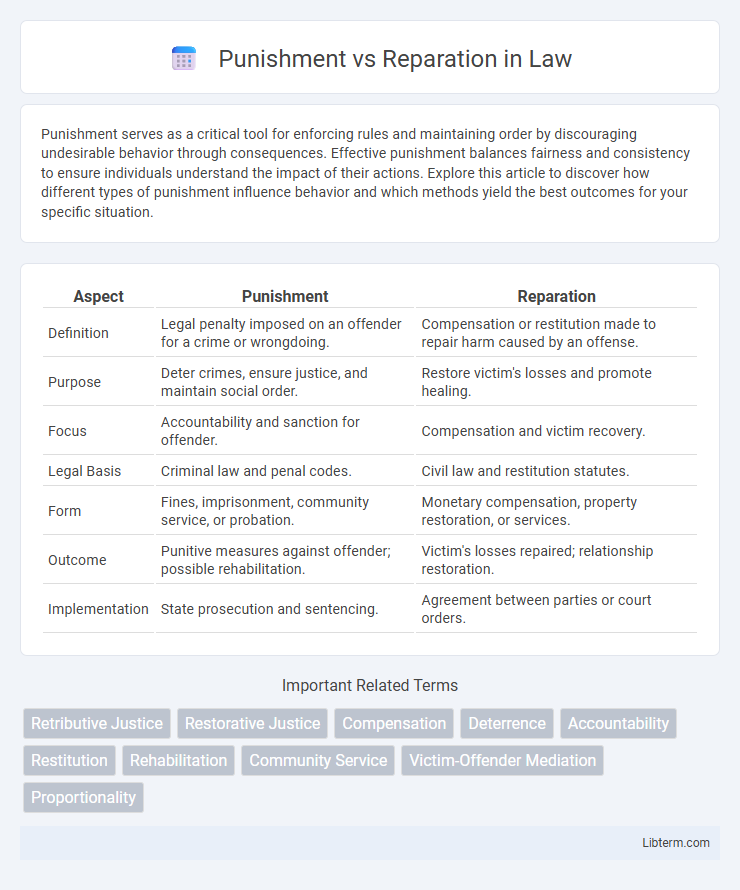Punishment serves as a critical tool for enforcing rules and maintaining order by discouraging undesirable behavior through consequences. Effective punishment balances fairness and consistency to ensure individuals understand the impact of their actions. Explore this article to discover how different types of punishment influence behavior and which methods yield the best outcomes for your specific situation.
Table of Comparison
| Aspect | Punishment | Reparation |
|---|---|---|
| Definition | Legal penalty imposed on an offender for a crime or wrongdoing. | Compensation or restitution made to repair harm caused by an offense. |
| Purpose | Deter crimes, ensure justice, and maintain social order. | Restore victim's losses and promote healing. |
| Focus | Accountability and sanction for offender. | Compensation and victim recovery. |
| Legal Basis | Criminal law and penal codes. | Civil law and restitution statutes. |
| Form | Fines, imprisonment, community service, or probation. | Monetary compensation, property restoration, or services. |
| Outcome | Punitive measures against offender; possible rehabilitation. | Victim's losses repaired; relationship restoration. |
| Implementation | State prosecution and sentencing. | Agreement between parties or court orders. |
Understanding Punishment and Reparation
Punishment serves to impose penalties on offenders, emphasizing deterrence and societal condemnation, while reparation aims to restore victims by compensating losses and promoting healing. Understanding punishment involves analyzing its role in maintaining social order through sanctions, whereas reparation centers on restorative justice principles that seek to rebuild trust and rectify harm. Effective justice systems balance both to address wrongdoing and support recovery.
Historical Context of Punishment and Reparation
Historical context reveals that punishment traditionally served as a deterrent and mechanism for social order, rooted in legal systems from ancient Hammurabi's Code to medieval European justice. Reparation emerged later as a restorative practice, aiming to compensate victims and repair harm, particularly evident in post-conflict treaties and truth and reconciliation commissions. This evolution reflects shifting societal values from retribution to restoration and reconciliation.
Philosophical Foundations: Justice and Fairness
Punishment and reparation stem from distinct philosophical foundations centered on justice and fairness. Punishment is grounded in retributive justice, emphasizing moral accountability and the proportional response to wrongdoing. Reparation prioritizes restorative justice, seeking to repair harm, restore relationships, and promote equitable outcomes for victims and communities.
Key Differences Between Punishment and Reparation
Punishment primarily aims to impose a penalty or consequence for wrongdoing, focusing on deterrence, retribution, or incapacitation, while reparation seeks to restore or compensate the victim for the harm caused. Punishment often involves sanctions such as fines, imprisonment, or community service, whereas reparation includes restitution, compensation, or rehabilitation efforts to repair damages. The key difference lies in punishment addressing the offender's culpability and societal norms, whereas reparation emphasizes victim restitution and healing.
Societal Impacts of Punitive Measures
Punitive measures often lead to increased recidivism rates and social stigmatization, hindering reintegration of offenders into society. Communities subjected to harsh punishments may experience heightened fear, reduced trust in legal systems, and widening socioeconomic disparities. The societal impact of punishment underscores the need for restorative justice approaches that prioritize healing and rehabilitation over mere retribution.
The Role of Reparation in Conflict Resolution
Reparation plays a critical role in conflict resolution by addressing the harm suffered by victims and fostering healing within communities. Effective reparations can include financial compensation, restorative justice programs, and public apologies, which help rebuild trust and promote social cohesion. Unlike punishment, reparation emphasizes restoration and reconciliation, contributing to long-term peace and the prevention of recurring violence.
Case Studies: Punishment vs Reparation in Practice
Case studies highlight contrasting outcomes between punishment and reparation approaches, revealing that reparation often facilitates community healing and long-term conflict resolution. For example, the South African Truth and Reconciliation Commission prioritized reparative measures, resulting in greater societal reconciliation compared to purely punitive systems. Conversely, some criminal justice models relying heavily on punishment demonstrate higher recidivism rates and limited restorative outcomes.
Psychological Effects on Offenders and Victims
Punishment often induces fear, shame, and resentment in offenders, potentially reinforcing criminal behavior rather than encouraging reform. Reparation fosters empathy, accountability, and healing by encouraging offenders to acknowledge harm and actively participate in restoring victims' well-being. Victims experience empowerment and closure through reparation, while punishment may leave lasting emotional trauma without addressing underlying psychological needs.
Legal Systems: Balancing Punishment and Reparation
Legal systems strive to balance punishment and reparation by ensuring offenders face consequences while addressing victims' needs for compensation. Punishment functions as a deterrent and societal condemnation, whereas reparation prioritizes restoring harm through financial or community-based remedies. Effective justice frameworks integrate both elements to promote accountability and repair social trust.
Future Trends: Shifting Towards Reparative Justice
Future trends in criminal justice emphasize reparative justice, focusing on healing victims and rehabilitating offenders rather than purely punitive measures. This approach integrates community involvement and restorative practices to reduce recidivism and foster social harmony. Emerging models prioritize accountability through meaningful restitution and dialogue, reshaping legal frameworks worldwide.
Punishment Infographic

 libterm.com
libterm.com